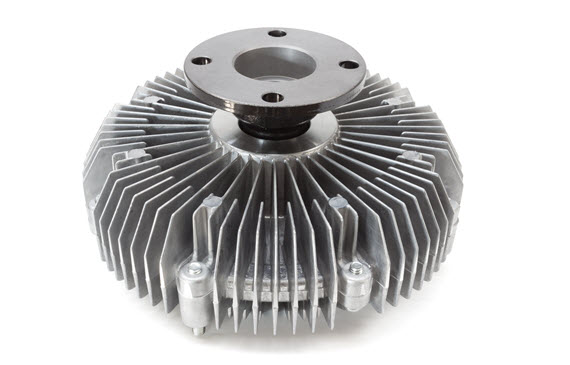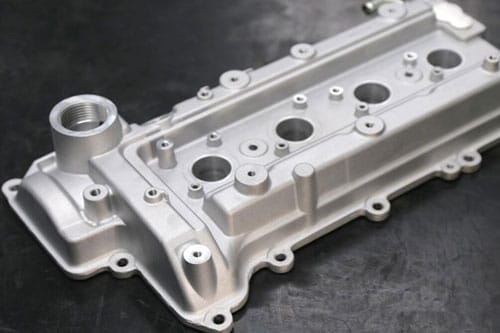Why Wisconsin Aluminum Foundry is trusted across various sectors
Discovering the Versatile Utilizes and Applications of Light Weight Aluminum Castings in Modern Industries
Light weight aluminum spreadings have become important to various modern markets as a result of their special properties. They supply considerable advantages in weight reduction, thermal conductivity, and deterioration resistance. From automobile developments to applications in durable goods and construction, their versatility is remarkable. Yet, truth extent of their impact expands past prompt benefits, hinting at more comprehensive effects for sustainability and effectiveness. What exists ahead for aluminum spreadings in an ever-evolving industrial landscape?
Automotive Sector Innovations
The automobile market has increasingly embraced light weight aluminum castings to improve lorry efficiency and effectiveness. By utilizing light weight aluminum, producers can create lighter parts, which add to enhanced fuel economic climate and decreased exhausts. Secret applications include engine blocks, transmission cases, and structural components, where the product's strength-to-weight ratio supplies resilience without adding excess weight.
Light weight aluminum castings likewise supply premium thermal conductivity, which helps in much better heat dissipation, thereby boosting engine performance. Additionally, developments in casting modern technologies, such as die spreading and sand spreading, make it possible for the production of complex geometries, enabling for cutting-edge layouts that enhance area and functionality.
The recyclability of aluminum aligns with sustainability objectives in the auto industry, advertising eco-friendly practices. As the sector continues to innovate, the use of aluminum castings is most likely to broaden, driving further developments in car style and efficiency.
Aerospace Applications and Improvements
While the aerospace industry remains to focus on weight decrease and fuel performance, aluminum castings have arised as a crucial material option for numerous applications. Their lightweight nature, coupled with high strength-to-weight ratios, enables considerable renovations in airplane efficiency and effectiveness. Light weight aluminum spreadings are commonly made use of in architectural elements, such as body frameworks and wing components, where minimizing weight is vital.
Recent innovations in light weight aluminum casting modern technologies, including enhanced alloy formulations and accuracy casting strategies, have further improved the material's efficiency capacities. These technologies allow the manufacturing of complex geometries and intricate styles while preserving structural stability. In addition, aluminum's superb rust resistance warranties longevity and dependability in harsh aerospace atmospheres.
As the aerospace sector progressively welcomes sustainability, aluminum castings supply a recyclable service that aligns with eco-friendly techniques, making them a critical aspect in the growth of next-generation airplane.
Consumer Item and Everyday Products
As customers increasingly seek light-weight yet sturdy products for everyday products, aluminum castings have actually gotten appeal in various durable goods. The unique properties of light weight aluminum, including its resistance to deterioration and outstanding thermal conductivity, make it an excellent choice for items like kitchenware, house devices, and outdoor equipment. For example, light weight aluminum cast pots and frying pans give also warmth circulation, boosting cooking effectiveness. In addition, making use of light weight aluminum in products such as bicycle frames and travel luggage assures an equilibrium between strength and portability. Makers appreciate light weight aluminum spreadings for their adaptability, as they can be conveniently built into complex forms while preserving structural integrity. The capability to recycle light weight aluminum without deteriorating its residential or commercial properties straightens with growing customer preferences for lasting products. On the whole, aluminum spreadings are essential to the manufacturing of resilient, useful, and visually pleasing consumer products, meeting the demands of modern-day lifestyles.
Building and Architectural Uses
Light weight aluminum castings have come to be a necessary component in building and building design, especially as a result of their stamina and light-weight nature. These residential properties make light weight aluminum an optimal selection for various applications, consisting of architectural components, facades, and ornamental attributes - Wisconsin Aluminum Foundry. Building contractors and architects progressively use light weight aluminum spreadings for window frames, doors, and roof, boosting both functionality and looks. The product's resistance to deterioration better prolongs its life expectancy, minimizing upkeep prices and making certain durability in diverse environmental problems
Aluminum can be easily molded right into detailed layouts, enabling for ingenious architectural expressions. Its flexibility helps with the creation of custom items that fulfill particular style requirements, from luxuriant barriers to intricate assistances. As sustainability comes to be a top priority, light weight aluminum's recyclability adds to its appeal in environmentally friendly construction techniques. Generally, aluminum castings are revolutionizing the building and construction market by offering light-weight, long lasting, and visually enticing remedies.
Digital and electrical Parts
Aluminum spreadings play a vital role in the manufacturing of lightweight electric enclosures, which boost portability and performance in various applications. In enhancement, their exceptional thermal conductivity makes them optimal for warm sinks, ensuring peak performance and long life of electronic elements. Aluminum's conductive residential properties contribute to its use in different electric conductors, stressing its importance in contemporary innovation.
Light-weight Electric Enclosures
Lightweight electrical units play a vital duty in protecting sensitive electronic components from environmental aspects and physical damage. Constructed from aluminum spreadings, these units are valued for their strength-to-weight proportion, making them suitable for numerous applications throughout sectors. Their light-weight nature help in lowering overall system weight, which is vital in mobile and portable electronics. Aluminum's corrosion resistance enhances sturdiness, prolonging the lifespan of the enclosed parts. The ability to mold aluminum right into intricate shapes permits customized layouts, satisfying certain demands while making sure efficient heat dissipation. In addition, these units can be quickly integrated right into existing systems, giving adaptability and convenience in modern technological settings. In general, lightweight light weight aluminum rooms significantly add to the effectiveness of electronic tools.
Warm Sinks and Conductors
While many products are utilized in digital elements, light weight aluminum castings stand out for their efficiency in warmth administration as warmth sinks and conductors. Their exceptional thermal conductivity permits reliable heat dissipation, which is crucial in avoiding the getting too hot of digital tools. Light weight aluminum's lightweight nature additionally enhances its viability for applications where weight is a considerable variable, such as in aerospace and automotive markets. In addition, aluminum spreadings can be conveniently molded right into intricate shapes, giving design versatility for maximizing thermal performance. The rust resistance of light weight aluminum additionally adds to the long life and reliability of these components in different settings. As technology advancements and gadgets come to be more small, the need for effective warm administration remedies, like light weight aluminum castings, remains to expand.
Marine Industry Application
The aquatic sector increasingly depends on aluminum castings for their extraordinary durability and corrosion resistance. These buildings make light weight aluminum an ideal choice for various applications, consisting of watercraft hulls, engine parts, and aquatic equipment. The light-weight nature of light weight aluminum castings allows improved fuel performance and less complicated ability to move in watercraft, which is essential for both commercial and entertainment vessels.

Aluminum spreadings likewise offer significant cost advantages due to their long life expectancy and low maintenance requirements, reducing the total functional expenses for aquatic operators. Additionally, the versatility of light weight aluminum enables elaborate designs that can fulfill particular efficiency demands.
Producers in the aquatic industry make use of sophisticated casting strategies to create complex shapes, ensuring that elements meet extensive safety and efficiency standards. As the need for high-performance aquatic vessels grows, light weight aluminum castings are positioned as a vital material in improving the performance and long life of marine tools.
Sustainability and Recycling in Aluminum Casting

Aluminum Recycling Process
Recycling light weight aluminum plays a crucial role in minimizing environmental impact and saving resources within the casting market. The light weight aluminum reusing procedure begins with the collection of scrap aluminum, which can include old components, manufacturing waste, and post-consumer products. This scrap is then arranged, cleansed, and shredded into tiny items to help with melting.
Once prepared, the aluminum scrap is thawed in a furnace at lower temperature levels than key aluminum production, considerably minimizing energy consumption. The liquified light weight aluminum is then cast into ingots or various other forms for reuse in numerous applications - Metal Castings. This closed-loop system allows for the reliable recuperation of aluminum, preserving its homes while decreasing the need for virgin products. As a result, the recycling procedure is a vital element of lasting methods in aluminum spreading
Ecological Advantages
While aluminum casting plays a critical function in different industries, its ecological benefits are specifically remarkable regarding sustainability and resource preservation. The lightweight nature of light weight aluminum contributes to power efficiency in transport, reducing fuel intake and discharges. Additionally, aluminum spreading facilitates using recycled products, significantly decreasing the energy required for manufacturing compared to main light weight aluminum. This recycling process lessens waste and lessens the environmental effect linked with mining and refining resources. Additionally, light weight aluminum is 100% recyclable without deterioration of its properties, promoting a lasting lifecycle. By choosing aluminum spreading, industries can substantially reduce their carbon footprint while promoting resource effectiveness, making it a necessary selection in the search of environmentally friendly manufacturing practices.
Closed-Loop Systems

Frequently Asked Concerns
What Are the Key Perks of Aluminum Castings Over Other Materials?
Aluminum castings supply lightweight residential properties, exceptional corrosion resistance, and high strength-to-weight ratios. They can be conveniently molded right into intricate shapes, supply excellent thermal and electrical conductivity, and are economical, making them preferable over lots of different materials.
How Is the Light Weight Aluminum Spreading Process Eco-friendly?
The light weight aluminum spreading process is ecologically pleasant as a result of its recyclability, reduced power consumption, and decreased waste production. Its capability to make use of recycled products minimizes the carbon footprint, promoting sustainability within producing methods.
What Are Usual Obstacles in Aluminum Spreading Production?
Common difficulties in aluminum casting production include preserving dimensional accuracy, handling thermal tightening, protecting against issues like porosity and incorporations, ensuring proper mold design, and optimizing production efficiency while reducing product waste and environmental effect.
Exactly How Do Light Weight Aluminum Castings Compare in Cost With Other Manufacturing Techniques?
Light weight aluminum castings normally supply affordable costs compared to various other producing techniques, particularly for medium to high-volume manufacturing. Their reduced initial tooling expenses and reliable product use can cause desirable business economics in time.
What Future Trends Are Anticipated in Light Weight Aluminum Casting Modern Technology?
Future patterns in aluminum spreading innovation are expected to include advancements in automation, boosted alloy structures, boosted recycling methods, and the assimilation of 3D printing, all focused on increasing effectiveness, reducing expenses, and decreasing ecological effect.
Current improvements in aluminum casting innovations, consisting of improved alloy solutions and precision spreading techniques, have better improved the product's performance abilities. Light weight aluminum castings have actually become a necessary component in building and construction and architectural style, specifically due to their strength and light-weight nature. The light weight aluminum recycling process starts with the collection of scrap light weight aluminum, which can include old components, producing waste, and post-consumer items. Once prepared, the aluminum scrap is thawed in a furnace at lower temperatures than main light weight aluminum production, significantly minimizing power consumption. Additionally, aluminum spreading promotes the usage of recycled materials, significantly reducing the power needed for manufacturing contrasted to key aluminum.